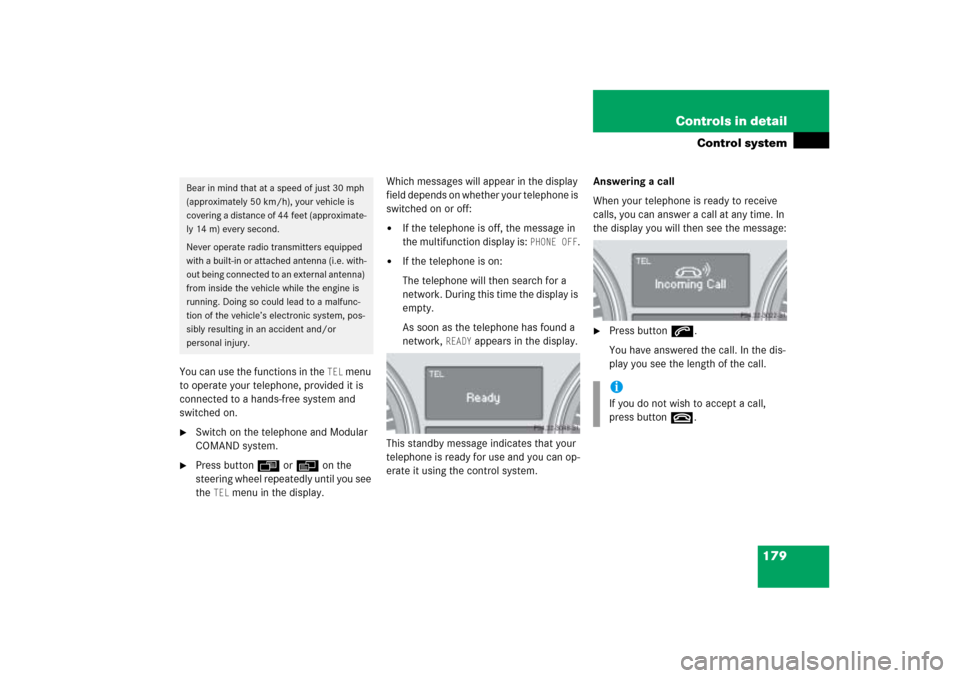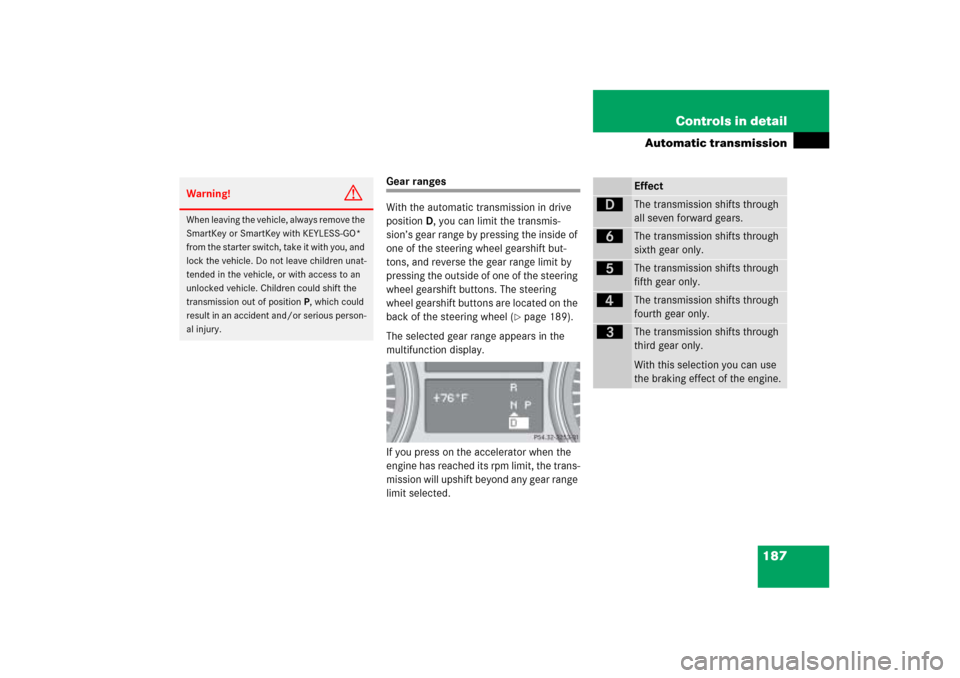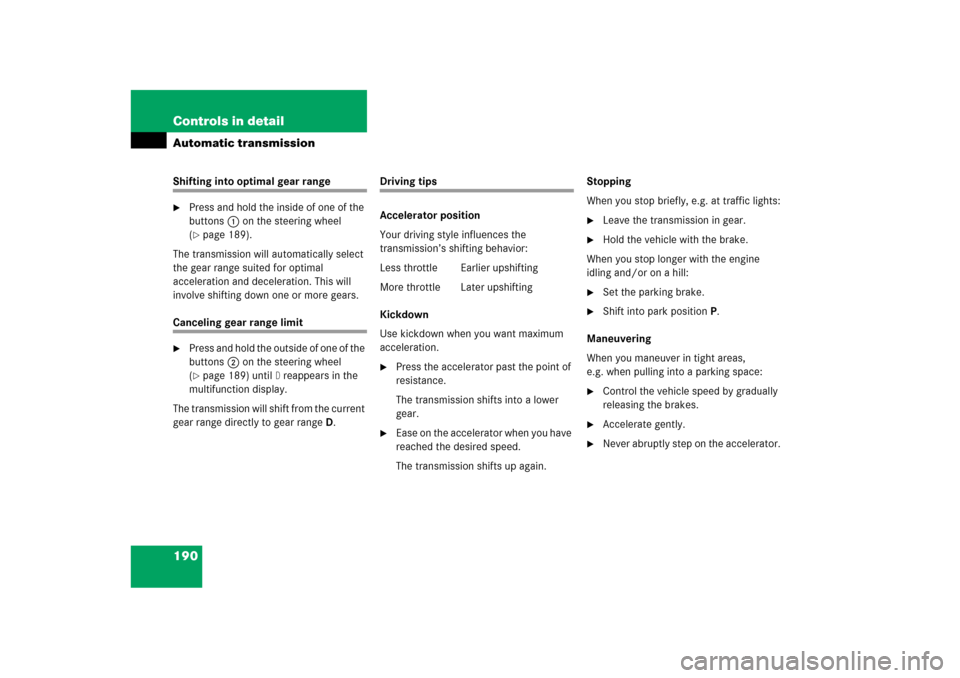Page 180 of 539

179 Controls in detail
Control system
You can use the functions in the
TEL
menu
to operate your telephone, provided it is
connected to a hands-free system and
switched on.
�
Switch on the telephone and Modular
COMAND system.
�
Press buttonÿ orè on the
steering wheel repeatedly until you see
the
TEL
menu in the display.Which messages will appear in the display
field depends on whether your telephone is
switched on or off:
�
If the telephone is off, the message in
the multifunction display is:
PHONE OFF
.
�
If the telephone is on:
The telephone will then search for a
network. During this time the display is
empty.
As soon as the telephone has found a
network,
READY
appears in the display.
This standby message indicates that your
telephone is ready for use and you can op-
erate it using the control system.Answering a call
When your telephone is ready to receive
calls, you can answer a call at any time. In
the display you will then see the message:
�
Press buttons.
You have answered the call. In the dis-
play you see the length of the call.
Bear in mind that at a speed of just 30 mph
(approximately 50 km/h), your vehicle is
covering a distance of 44 feet (approximate-
ly 14 m) every second.
Never operate radio transmitters equipped
with a built-in or attached antenna (i.e. with-
out being connected to an external antenna)
from inside the vehicle while the engine is
running. Doing so could lead to a malfunc-
tion of the vehicle’s electronic system, pos-
sibly resulting in an accident and/or
personal injury.
iIf you do not wish to accept a call,
press buttont.
Page 185 of 539

184 Controls in detailAutomatic transmissionShifting from D, R, or N to P
If you want to select park positionP with
the transmission being in drive positionD,
reverse positionR or neutral positionN:�
Depress the brake pedal and keep it
pressed.
�
Step firmly on parking brake pedal
(�page 52).
�
Press button at the end of the gear
selector lever in direction of arrow
(�page 182) to select park positionP.
�
Release the brake.
Shifting procedure
The automatic transmission selects indi-
vidual drive gears automatically, depend-
ing on:�
drive positionD with gear ranges
(�page 187)
�
the position of the accelerator pedal
(�page 190)
�
the vehicle speed
The current transmission gear selection
appears in the multifunction display.
With gear positionD selected, you can use
the steering wheel gearshift control but-
tons (
�page 189) to influence transmis-
sion shifting by:
�
limiting the gear range
�
changing gears manually
!Shift the automatic transmission
directly from positionD toR, fromR
toD or dire c tly to pos itionP only when
the vehicle is stopped. Otherwise the
automatic transmission could be
damaged.
When trying to free a vehicle stuck in
mud or snow, see “Rocking the vehicle”
(�page 191).
!Allow engine to warm up under low
load use. Do not place full load on the
engine until the operating temperature
has been reached.
Shift into reverse gearR or park
positionP only when the vehicle is
stopped.
Avoid spinning of a drive wheel for an
extended period when driving off on
slippery road surfaces. This may cause
serious damage to the drivetrain which
is not covered by the Mercedes-Benz
Limited Warranty.
Page 188 of 539

187 Controls in detail
Automatic transmission
Gear ranges
With the automatic transmission in drive
positionD, you can limit the transmis-
sion’s gear range by pressing the inside of
one of the steering wheel gearshift but-
tons, and reverse the gear range limit by
pressing the outside of one of the steering
wheel gearshift buttons. The steering
wheel gearshift buttons are located on the
back of the steering wheel (
�page 189).
The selected gear range appears in the
multifunction display.
If you press on the accelerator when the
engine has reached its rpm limit, the trans-
mission will upshift beyond any gear range
limit selected.
Warning!
G
When leaving the vehicle, always remove the
SmartKey or SmartKey with KEYLESS-GO*
from the starter switch, take it with you, and
lock the vehicle. Do not leave children unat-
tended in the vehicle, or with access to an
unlocked vehicle. Children could shift the
transmission out of positionP, which could
result in an accident and/or serious person-
al injury.
Effect
ê
The transmission shifts through
all seven forward gears.
ï
The transmission shifts through
sixth gear only.
î
The transmission shifts through
fifth gear only.
é
The transmission shifts through
fourth gear only.
è
The transmission shifts through
third gear only.
With this selection you can use
the braking effect of the engine.
Page 191 of 539

190 Controls in detailAutomatic transmissionShifting into optimal gear range�
Press and hold the inside of one of the
buttons1 on the steering wheel
(�page 189).
The transmission will automatically select
the gear range suited for optimal
acceleration and deceleration. This will
involve shifting down one or more gears.
Canceling gear range limit�
Press and hold the outside of one of the
buttons2 on the steering wheel
(�page 189) until
D reappears in the
multifunction display.
The transmission will shift from the current
gear range directly to gear rangeD.
Driving tips
Accelerator position
Your driving style influences the
transmission’s shifting behavior:
Less throttle Earlier upshifting
More throttle Later upshifting
Kickdown
Use kickdown when you want maximum
acceleration.�
Press the accelerator past the point of
resistance.
The transmission shifts into a lower
gear.
�
Ease on the accelerator when you have
reached the desired speed.
The transmission shifts up again.Stopping
When you stop briefly, e.g. at traffic lights:
�
Leave the transmission in gear.
�
Hold the vehicle with the brake.
When you stop longer with the engine
idling and/or on a hill:
�
Set the parking brake.
�
Shift into park positionP.
Maneuvering
When you maneuver in tight areas,
e.g. when pulling into a parking space:
�
Control the vehicle speed by gradually
releasing the brakes.
�
Accelerate gently.
�
Never abruptly step on the accelerator.
Page 241 of 539

240 Controls in detailDriving systems
Canceling cruise control
There are several ways to cancel the cruise
control:�
Step on the brake pedal.
The cruise control is canceled. The last
speed set is stored for later use.
or
�
Briefly push the cruise control lever in
direction of arrow3 (
�page 239).
The cruise control is canceled. The last
speed set is stored for later use.
iOn uphill grades, the cruise control
may not be able to maintain the set
speed. Once the grade eases, the set
speed will be resumed.
On downhill grades, the cruise control
maintains the set speed with braking
from the vehicle’s braking system. In
addition, on longer downhill grades the
automatic transmission will automati-
cally downshift.
iThe last stored speed is canceled when
you turn off the engine.
iThe cruise control switches off auto-
matically when�
you step on the brake pedal
�
you depress the parking brake
pedal
The cruise control also switches off au-
tomatically when
�
the vehicle speed is below 20 mph
(30 km/h)
�
the ESP
® is in operation or
switched off with the ESP
® switch
(
�page 97)
�
you set the automatic transmission
toN while driving
An acoustic warning sounds and the
message
Cruise control OFF
appears
in the multifunction display.
Page 245 of 539

244 Controls in detailDriving systemsFor more information, see “Off-road driv-
ing” (
�page 306).
The DSR is an aid for driving downhill. DSR
regulates your vehicle’s speed when driv-
ing downhill to the value set in the control
system (�page 176). The steeper the
downhill gradient is, the greater the brake
application. On flat road surfaces, DSR
brakes only slightly or not at all.
DSR regulates the vehicle’s speed in auto-
matic transmission positionsD, orR.
You can drive slower or faster than the set
speed at any time by braking the vehicle or
depressing the accelerator pedal.
iWhenever DSR is switched on, DSR will
use the programmed default speed to
regulate the vehicle’s speed. The de-
fault speed programmed at the factory
is 4 mph (Canada: 6 km / h). The de-
fault speed can be reprogrammed us-
ing the control system (
�page 176).
The next time DSR is switched on, DSR
will use the newly programmed default
speed to regulate the vehicle’s speed.
Once DSR is switched on, you can ad-
just the set speed using the cruise con-
trol lever (
�page 238). Keep in mind
that adjusting the set speed using the
cruise control lever with DSR switched
on will not change the programmed de-
fault speed. If DSR is switched off and
then switched on again, DSR will use
the programmed default speed.
Whenever the DSR is switched on, the
programmed default speed will be
used. That value can be changed
through the multifunction display. The
next time the DSR is switched on, it will
use that newly programmed default
speed.
Depending on the road surface and lev-
el of downhill grade, the DSR may not
be able to maintain the set speed. To
maintain the set speed, apply the
brakes if necessary.
Page 246 of 539

245 Controls in detail
Driving systems
Switching the Downhill Speed
Regulation on/off
The switch is located in the lower part of
the center console.Switch for DSR1DSR on/off
2Indicator lampSwitching Downhill Speed Regulation on
�
Press DSR switch1 (
�page 245).
The indicator lamp2 comes on.
The message
DSR
and the set speed ap-
pear in the multifunction display.
Warning!
G
If the accelerator pedal is depressed while
the Downhill Speed Regulation is activated,
the vehicle can drive faster than the pro-
grammed set speed. You should therefore
drive downhill with particular caution as it
could otherwise lead to an accident and/or
serious injury to you or others. Keep in mind
that as soon as you remove the foot from
the accelerator pedal with the DSR switched
on, the DSR will start regulating the vehicle’s
speed including use of brakes where re-
quired. Depending on the programmed set
speed, actual vehicle speed and gradient,
the DSR can cause the vehicle to slow down
rapidly. Sudden and unexpected decelara-
tion can result in loss of vehicle control,
causing an accident and/or serious person-
al injury to you and others.
iThe DSR can only be switched on if the
vehicle speed is below 18 mph
(Canada: 30 km/h).
Page 247 of 539

246 Controls in detailDriving systemsFor information on how to program the set
speed while driving, see “Adjusting Down-
hill Speed Regulation speed with DSR
switched on” (
�page 246).Switching Downhill Speed Regulation off
�
Press DSR switch1 (
�page 245).
The indicator lamp2 goes out.
The message
DSR off
appears in the
multifunction display.Adjusting Downhill Speed Regulation
speed with DSR switched on
With the DSR switched on (
�page 245),
the speed setting can be changed using
the cruise control lever.
Cruise control lever1Increase set speed
2Reduce set speed
You can change the set speed between
3 - 10 mph (Canada: 4 - 18 km/h).
The cruise control lever is the uppermost
lever on the left-hand side of the steering
column (
�page 23).
iIf the DSR is switched on at a speed
above 18 mph (Canada: 30 km/h), the
message
DSR Cannot be activated,
Speed too high
appears in the multi-
function display.
iAt a speed above approximately
21 mph (Canada approx.: 35 km/h),
the DSR is automatically switched off.
The message
DSR off
appears in the
multifunction display and an acoustic
signal sounds.